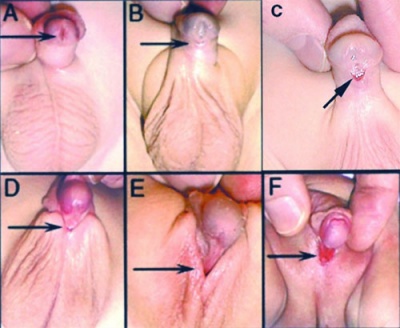Genital Abnormality - Hypospadia: Difference between revisions
| Line 1: | Line 1: | ||
==Introduction== | ==Introduction== | ||
Hypospadias are the most common penis abnormality (1 in 300) and result from a failure of male urogenital folds to fuse in various regions, the normal process is described as virilization of the external genitalia. This in turn leads to resulting in a proximally displaced urethral meatus. The cause is unknown, but suggested to involve many factors either indivdually or in combination including: familial inheritance, low birth weight, assisted reproductive technology, advanced maternal age, paternal subfertility and endocrine-disrupting chemicals.<ref name="PMID11713004"><pubmed>11713004</pubmed></ref> Infants with hypospadias should not undergo circumcision. | Hypospadias are the most common penis abnormality (1 in 300) and result from a failure of male urogenital folds to fuse in various regions, the normal process is described as virilization of the external genitalia. This in turn leads to resulting in a proximally displaced urethral meatus or opening. The cause is unknown, but suggested to involve many factors either indivdually or in combination including: familial inheritance, low birth weight, assisted reproductive technology, advanced maternal age, paternal subfertility and endocrine-disrupting chemicals.<ref name="PMID11713004"><pubmed>11713004</pubmed></ref> Infants with hypospadias should not undergo circumcision. | ||
==Some Recent Findings== | ==Some Recent Findings== | ||
Revision as of 11:46, 19 June 2010
Introduction
Hypospadias are the most common penis abnormality (1 in 300) and result from a failure of male urogenital folds to fuse in various regions, the normal process is described as virilization of the external genitalia. This in turn leads to resulting in a proximally displaced urethral meatus or opening. The cause is unknown, but suggested to involve many factors either indivdually or in combination including: familial inheritance, low birth weight, assisted reproductive technology, advanced maternal age, paternal subfertility and endocrine-disrupting chemicals.[1] Infants with hypospadias should not undergo circumcision.
Some Recent Findings
- Correction of Distal Penile Hypospadias
- [2] "The major aims of correction of hypospadias include construction of a neourethra, removal of the chordee, and reduction of the probability of postoperative fistulization. Here, we describe a new technique that can be easily used in cases with subcoronal distal penile hypospadias (even those with chordee) for the construction of the urethra using meatus-based transverse flaps."
- [3] "Meatal mobilization (MEMO) by distal urethral preparation has been demonstrated to be an efficient surgical technique for the correction of distal hypospadias offering excellent short-term success rates."
Hypospadia Classification

The condition is classified by the general location of the relocated opening (meatus) and lack of fusion.
Anterior Hypospadia
- A Meatus located on inferior surface of glans penis.
Coronal Hypospadia
- B Meatus located in balanopenile furrow.
Distal Hypospadia
- C Meatus located on distal third of shaft.
Penoscrotal Hypospadia
- D Meatus located at base of shaft in front of scrotum.
Scrotal Hypospadia
- E Meatus located on scrotum or between the genital swellings.
Perineal Hypospadia
- F Meatus located behind scrotum or genital swellings.
Surgical Repair
Depending on the class of hypospadias there are a number of different surgical repair techniques including: orthoplasty or penile straightening, urethroplasty, meatoplasty and glanuloplasty, scrotoplasty (oscheoplasty) and skin coverage.
Molecular Factors
- chromosomal abnormalities
- HOX, FGF, Shh - genes of penile development
- WT1, SRY - testicular determination
- luteinizing hormone (LH) receptor
- 5alpha reductase, androgen receptor - action of androgen
- CXorf6
- ATF3
Related Genetic Conditions
- Johanson-Blizzard syndrome[4] - hypospadias, failure to thrive, exocrine pancreatic deficiency, short stature and developmental delay, cutis aplasia on the scalp, aplasia of alae nasi, hypothyroidism, myxomatous mitral valve, and patent ductus arteriosus.
References
Reviews
Articles
Search Pubmed
June 2010 "Hypospadia" All (4698) Review (377) Free Full Text (413)
Search Pubmed: Hypospadia | Hypospadia Surgical Repair
External Links
Glossary Links
- Glossary: A | B | C | D | E | F | G | H | I | J | K | L | M | N | O | P | Q | R | S | T | U | V | W | X | Y | Z | Numbers | Symbols | Term Link
Cite this page: Hill, M.A. (2024, May 1) Embryology Genital Abnormality - Hypospadia. Retrieved from https://embryology.med.unsw.edu.au/embryology/index.php/Genital_Abnormality_-_Hypospadia
- © Dr Mark Hill 2024, UNSW Embryology ISBN: 978 0 7334 2609 4 - UNSW CRICOS Provider Code No. 00098G